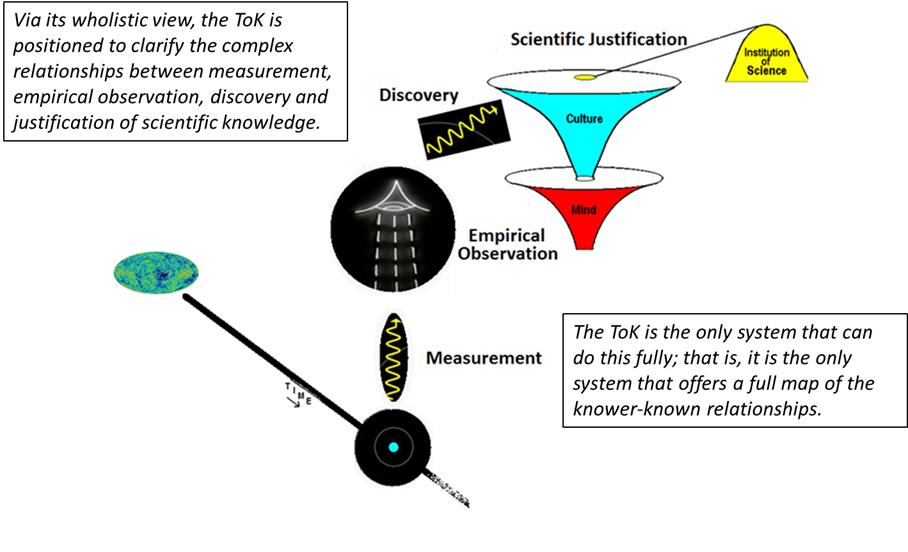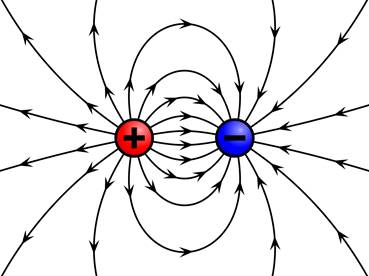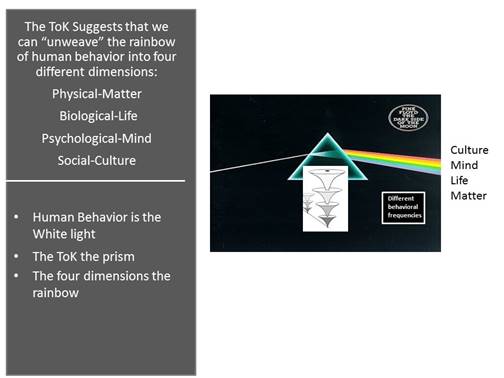Interesting idea.
A few loose associations:
This starts to remind me of Kant’s categories of mind.
It also reminds me of my symbolic representation of behavior, which is X[Xo]t
- X[Xo]t’. X is the object, Xo is the field and the – is the difference or change. Thus, it is change in object-field relationship. We can ask, what is the functional form of the behavior change? I believe the Periodic
Table of behavior captures the taxonomy of such changes in the natural world.
Finally, it reminds me of Aristotle’s four causes. Material and Kinetic most obviously. Then there is the formal cause, which I believe relates deeply to the concept of inFORMation. I also believe that the “final cause” relates to negentropic
complexity, which would also relate to information.
Best,
Gregg
From: tree of knowledge system discussion <[log in to unmask]>
On Behalf Of nysa71
Sent: Wednesday, February 5, 2020 9:17 AM
To: [log in to unmask]
Subject: Re: Part II on 11th Problem
Gregg,
You're certainly welcome. ![]()
Here's another angle in regards to "The Knower" and the basic classes of information ("The Known") processed by "The Knower".
At the first dimension of the ToK, we have:
-
Space-Time
-
Matter-Energy
So could we --- in the broadest and most abstract sense --- meaningfully classify four types of information processed by "The Knower"?
-
Spatial information
-
Temporal information
-
Material information
-
Energetic information
~ Jason
On Tuesday, February 4, 2020, 11:50:05 AM EST, Henriques, Gregg - henriqgx <[log in to unmask]> wrote:
Good extension. I am following.
Let me also share that I love the idea that the brain is the skin turned in on itself. I often like to imagine it as an “internal inverted skin arena” that plays
out via digital-analogue-virtual processing the agent-arena changes on the outside. This offers another angle that jives with your idea.
With that said, let me move the other direction. We can note that our phenomenology, especially as it is oriented toward the external senses, is organized in an
“object-field” way on the inside. That is, we perceive, effortlessly and automatically figure (i.e., object) ground (i.e., field) relations. When phenomenologists talk about “intentionality” they note that our conscious experience is directed at things.
This blog on perceptions and perceptual illusions captures that point to some degree. Indeed, one of the things that was helpful getting my “information interface” model of human mental behavior down when I was reflecting on the nature of human language
was to realize our phenomenological/subjective FIELD (!J) corresponded with the basic syntactical units. Specifically, we perceive
things (objects) which are tagged as nouns, changes in the object field relation (tagged as verbs) and difference (which are adjectives). So, our external and linguistic categories of mind, to use a Kant reference, are designed to perceive behavioral change
in the world (that is relevant to our lives).
Bottom line is that I think we are cohering here nicely. Many thanks sharing for this interesting angle that I had not considered.
G
From: tree of knowledge system discussion <[log in to unmask]>
On Behalf Of nysa71
Sent: Tuesday, February 4, 2020 11:35 AM
To: [log in to unmask]
Subject: Re: Part II on 11th Problem
Gregg: "...the FULL behavioral field requires the placement of the human knower and the relationship between the empirical measurement and the
placement in human justification systems."
Me: I think this helps clarify how the object-field relationship can help clarify the association between objects and field on the one hand, and the Jungian conceptualization of extraversion (turning outwards) and introversion (turning inwards), on the other.
If "The Knower" is taking an extraverted perspective, they are (in a manner of speaking) "moving towards" the (behavioral) object. That is, the more "outwardly-turning" they are, the more they are moving towards the object.
However, if "The Knower" is taking an introverted perspective, they are (in a manner of speaking) "moving away from" the object, and hence distancing themselves from the object, and thus getting a broader perspective of the context of the object, (i.e., the
field).
~ Jason
On Tuesday, February 4, 2020, 06:02:59 AM EST, Henriques, Gregg - henriqgx <[log in to unmask]>
wrote:
Brilliant!
Yes, the ToK can be thought of as a proposal to map the “behavioral field” mapped by science’s third person exterior observe/measure/experiment theories of behavioral change.
It starts with the singular substance at the Big Beginning. This is the singular and absolute largest point. Planck’s constant is the absolute smallest empirically observable behavioral
unit (the smallest “particular”), and sets the limits on the “smallness” of measurable
units of space and time.
And finally, there is the human scientist knower and the “place” of human knowledge…This is what the diagram is getting at. Notice, if you check the link above, you will see the
standard representation of the “measurement field”; however, the FULL behavioral field requires the placement of the human knower and the relationship between the empirical measurement and the placement in human justification systems.
G

From: tree of knowledge system discussion <[log in to unmask]>
On Behalf Of nysa71
Sent: Monday, February 3, 2020 8:14 PM
To: [log in to unmask]
Subject: Re: Part II on 11th Problem
Gregg: "[The ToK] is a picture of the ultimate field...What is it really a field of?"
Me: A Behavioral Field?
~ Jason
On Monday, February 3, 2020, 11:44:14 AM EST, Henriques, Gregg - henriqgx <[log in to unmask]> wrote:
Jason Bessey wrote:
It would seem that the image that popped into your head (the ToK…) represents the ultimate field.
Yes, yes, yes!!! It is a picture of the ultimate field.
Then the next question is…ok,
what is it really a field of? In physics, a field is a physical quantity of (tensor) relations. Illustrated here:

What do the lines represent? They represent the “messenger particles communicating forces” between the primary material nodes (of say an electron and proton communicating the electromagnetic
force via photons as messenger particles).
What the ToK posits that the “frequency of fields” vibrate/exist at different planes. The Organism-Life plane refers to information instantiated and processed by the cell and communicated
between cells. We call such patterns living behavioral processes. (In other words, imagine the two nodes as cells, communicating via chemicals)
The Animal-Mind plane presents the information instantiated and processed by the brain-nervous system and communicated between animals. We call such patterns mental behavioral
processes. (In other words, imagine those two nodes as rats, communicating via sensory motor processes)
The Person-Culture plane represents the information instantiated and processed by the ego (mental organ of linguistic justification) and communicated between persons. We call such
patterns cultural behavioral processes (this email J).
This is why the ToK is a prism through which decipher the frequencies of behavior:

The ultimate field view! That is what we are after to sort out the issues.
Best,
Gregg
From: tree of knowledge system discussion <[log in to unmask]>
On Behalf Of nysa71
Sent: Monday, February 3, 2020 11:25 AM
To: [log in to unmask]
Subject: Re: Part II on 11th Problem
Hi Gregg,
What you seem to be describing is what Jung called,"introverted intuition":
-
"Intuition, in the introverted attitude, is directed upon the inner object, a term we might justly apply to the elements of the unconscious. For the relation of inner objects to consciousness is entirely analogous to that of outer
objects, although theirs is a psychological and not a physical reality. Inner objects appear to the intuitive perception as subjective images of things, which, though not met with in external experience, really determine the contents of the unconscious, i.e.
the collective unconscious, in the last resort. Naturally, in their per se character, these contents are, not accessible to experience, a quality which they have in common with the outer object. For just as outer objects correspond only relatively with our
perceptions of them, so the phenomenal forms of the inner object are also relative; products of their (to us) inaccessible essence and of the peculiar nature of the intuitive function. Like sensation, intuition also has its subjective factor, which is suppressed
to the farthest limit in the extraverted intuition, but which becomes the decisive factor in the intuition of the introvert. Although this intuition may receive its impetus from outer objects, it is never arrested by the external possibilities, but stays with
that factor which the outer object releases within." [Source]
Also, in light of our discussion in another thread about associating introversion with
fields (as opposed to associating extraversion with objects) it would seem that the image that popped into your head (the ToK and your and psychology's
relationship to it) represents the ultimate field.
~ Jason Bessey
Also, in light of our discussion in another thread about associating introversion with
fields (as opposed to associating extraversion with objects) it would seem that the image that popped into your head (the ToK and your and psychology's
relationship to it) represents the ultimate field.
~ Jason Bessey
On Monday, February 3, 2020, 10:24:08 AM EST, Henriques, Gregg - henriqgx <[log in to unmask]> wrote:
Hi TOK List,
Here is the second part of the blog series I did with Dr. John Vervaeke on the “onto-normativity” problem. In it, I share a “transcendent experience” I had and then look at
it through the lens he had developed called the “continuity hypothesis” which explains how transcendental experiences can be thought of as enhanced flow-into-altered states that enable people to get a more “optimal grip” on the self-world (or agent-arena)
relationship:
https://www.psychologytoday.com/us/blog/theory-knowledge/202002/the-11th-problem-consciousness
Here is the link to Part I if you did not see that:
https://www.psychologytoday.com/us/blog/theory-knowledge/202001/the-11th-problem-consciousness
Best,
Gregg
___________________________________________
Gregg Henriques, Ph.D.
Professor
Department of Graduate Psychology
216 Johnston Hall
MSC 7401
James Madison University
Harrisonburg, VA 22807
(540) 568-7857 (phone)
(540) 568-4747 (fax)
Be that which enhances dignity and well-being with integrity.
Check out my Theory of Knowledge blog at Psychology Today at:
https://www.psychologytoday.com/blog/theory-knowledge
############################
To unsubscribe from the TOK-SOCIETY-L list: write to:
mailto:[log in to unmask] or click the following link:
http://listserv.jmu.edu/cgi-bin/wa?SUBED1=TOK-SOCIETY-L&A=1
############################
To unsubscribe from the TOK-SOCIETY-L list: write to:
mailto:[log in to unmask] or click the following link:
http://listserv.jmu.edu/cgi-bin/wa?SUBED1=TOK-SOCIETY-L&A=1
############################
To unsubscribe from the TOK-SOCIETY-L list: write to:
mailto:[log in to unmask] or click the following link:
http://listserv.jmu.edu/cgi-bin/wa?SUBED1=TOK-SOCIETY-L&A=1
############################
To unsubscribe from the TOK-SOCIETY-L list: write to:
mailto:[log in to unmask] or click the following link:
http://listserv.jmu.edu/cgi-bin/wa?SUBED1=TOK-SOCIETY-L&A=1
############################
To unsubscribe from the TOK-SOCIETY-L list: write to:
mailto:[log in to unmask] or click the following link:
http://listserv.jmu.edu/cgi-bin/wa?SUBED1=TOK-SOCIETY-L&A=1
############################
To unsubscribe from the TOK-SOCIETY-L list: write to:
mailto:[log in to unmask] or click the following link:
http://listserv.jmu.edu/cgi-bin/wa?SUBED1=TOK-SOCIETY-L&A=1
############################
To unsubscribe from the TOK-SOCIETY-L list: write to:
mailto:[log in to unmask] or click the following link:
http://listserv.jmu.edu/cgi-bin/wa?SUBED1=TOK-SOCIETY-L&A=1
############################
To unsubscribe from the TOK-SOCIETY-L list: write to:
mailto:[log in to unmask] or click the following link:
http://listserv.jmu.edu/cgi-bin/wa?SUBED1=TOK-SOCIETY-L&A=1